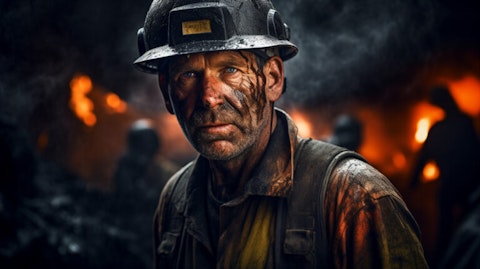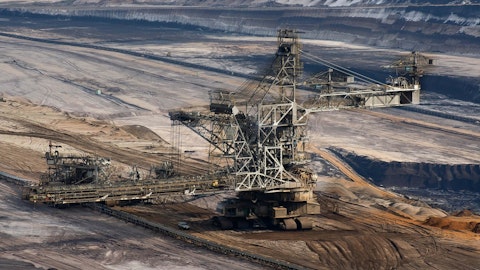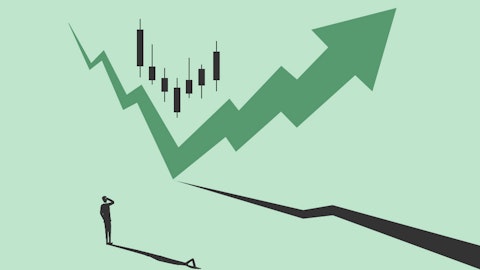Arch Resources, Inc. (NYSE:ARCH) Q3 2023 Earnings Call Transcript October 26, 2023
Arch Resources, Inc. beats earnings expectations. Reported EPS is $3.91, expectations were $3.26.
Operator: Good morning, and welcome to the Arch Resources Third Quarter 2023 Earnings Call. All participants will be in a listen-only mode. [Operator Instructions] Please note, this event is being recorded. I would like now to turn the conference over to Deck Slone, Senior Vice President of Strategy. Please go ahead.
Deck Slone: Good morning from St. Louis, and thanks for joining us today. Before we begin, let me remind you that certain statements made during this call, including statements relating to our expected future business and financial performance may be considered forward-looking statements according to the Private Securities Litigation Reform Act. Forward-looking statements, by their nature, address matters that are to different degrees uncertain. These uncertainties, which are described in more detail in the annual and quarterly reports that we file with the SEC may cause our actual future results to be materially different than those expressed in our forward-looking statements. We do not undertake to update our forward-looking statements, whether as a result of new information, future events or otherwise, except as may be required by law.

A coal miner emerging from a vast underground mining operation, his clothes blackened from the day’s work.
I’d also like to remind you that you can find a reconciliation of the non-GAAP financial measures that we plan to discuss this morning at the end of our press release, a copy of which we have posted in the Investors section of our website at archrsc.com. Also participating on this morning’s call will be Paul Lang, our CEO; John Drexler, our COO; and Matt Giljum, our CFO. After our formal remarks, we’ll be happy to take questions. With that, I’ll now turn the call over to Paul. Paul?
Paul Lang: Thanks Dick and good morning, everyone. We appreciate your interest in Arch, and are glad you could join us on the call this morning. I’m pleased to report that during the third quarter, the Arch team continued to drive forward with our simple, consistent and actionable plan for long term value creation and growth. During the quarter just ended, the Arch team achieved an adjusted EBITDA of $126.3 million, generated $86.5 million in discretionary cash flow, invested $28.2 million to repurchase nearly 216,000 shares, and finally declared a quarterly cash dividend of $21.6 million, or $1.13 per share. In short Q3 served to underscore yet again, the value driving of Arch’s capital return program, which we view as the centerpiece of our value proposition.
Since February 2022 we’ve deployed more than $1.2 billion through the program, including the reduction of the equivalent of 4.3 million shares in the form of common stock, and convertible note repurchases, plus the issuance of nearly $662 million in dividends, inclusive of the payment to be made to shareholders in December. When combined with phase one of the program during the 2017 through 2019 time period, we’ve now returned more than $2.1 billion to shareholders. To review the central tenet of the capital return program would be the commitment to effectively return 100% of our discretionary cash flow to shareholders, a commitment that is foundational to the program structure. In contrast, we view the program’s capital allocation model, which is to say the precise manner in which the capital is returned to be flexible and dynamic.
Indeed, the Board evaluates capital allocation model on a more or less continual basis as an endeavor to ensure that capital is returned to shareholders in the most optimal way. Recently, and as a function of that ongoing evaluation process, the Board concluded that an adjustment to the capital allocation model made sense at this time. As a result, the Board decided to ratchet down the relative weighting to dividend, while at the same time preserving a meaningful cash balance that can be diverted towards share repurchases during periods of market weakness. It’s important to highlight here that the Board continues to view a significant dividend as the integral component of Arch’s long term capital return strategy. We believe that the return of cash is a clear, direct and unambiguous way to reward shareholders for their continuing support and confidence.
But at present, we believe that directing a larger percentage of our discretionary cash flow to share repurchases makes sense given Arch’s ongoing progress on its key strategic objectives, the company’s promising long term outlook and the ongoing evolution of the preferences of Arch’s shareholders. Turning now to the market dynamics, we’ve seen a significant strength in the global coal markets in recent months, despite continuing weakness in the macro environment. Let’s start with global coking coal markets where High-Vol A coal Arch’s principal product is being assessed at $277 per metric ton off the East Coast of the United States, which is a strong price level when compared to historical averages. What’s more interesting in our view, is that coking coal prices continue to trace these elevated levels, despite relatively weak steel market dynamics.
As an indication of this weakness, global output of hot metal, the end use the vast majority of Arch’s coking coal is down roughly 1% year-to-date, falling the decline of nearly 10% in 2022 counterbalancing that weak demand environment to a large degree are continuing constraints in metallurgical coal supply. Year-to-date, coking coal exports from Australia, the largest supplier of metallurgical coal to seaborne market, are undershooting the already weak 2022 levels by roughly 5 million tons and heading to an over 35 million ton, or almost 20% decrease from their high watermark in 2016. Meanwhile exports from the United States and Canada, the other major sources of high quality coking coal supply to the seaborne market remained relatively range bound, despite persistently strong pricing in recent years.
As we’ve noted repeatedly, the global investment in new and existing mine capacity has been extremely muted the last several years due to increasing development costs, mining regulatory pressures, and a host of other ESG-related concerns. And we see no evidence of that changing in the near future. Indeed, we suspect that even a modest improvement in global macroeconomic conditions could drive additional supply tightness well into the future. As for the seaborne thermal coal markets, we see a similar dynamic, with lackluster demand being counterbalanced by years of under supply. While our thermal assets are effectively sold out at fixed prices for 2023 we expect current thermal market dynamics and pricing levels should they persist, to support substantial margins on our thermal export volumes in 2024 and beyond.
Looking ahead, we remain sharply focused on delivering operational excellence consistently quarter-after-quarter and year-after-year, capitalizing on while we expect to be constructive seaborne coal markets well into the future, maintaining and augmenting our already strong financial position, continue to reward shareholders for their support and confidence through our capital return program, and advancing our industry-leading sustainability practices. Through these substantial and ongoing efforts we’re laying a strong and durable foundation for growth and long term value creation, as well as setting the stage for ongoing improvements in our mid-cycle free cash flow generation. I’ll now turn the call over to John Drexler for further discussion of our operational performance in Q3.
John?
John Drexler: Thanks, Paul, and good morning, everyone. As Paul just discussed, the Arch team delivered solid results, and $86.5 million in discretionary cash flow despite constrained advance rates at Leer South during the third quarter. Our core metallurgical segment delivered higher per ton realizations and stronger cash margins on a sequential basis, while maintaining a cost structure that, while elevated relative to expectations, placed us comfortably in the first quartile of U.S. coking coal producers. In addition, our thermal segment delivered solid supplemental cash flows, well in excess of its capital requirements, despite a roughly breakeven performance at West Elk. In short, our talented workforce and high quality operating portfolio continue to deliver significant value for shareholders, even as we address some near term challenges and laid the foundation for stronger results in the future.
I also want to highlight the continuing upward trajectory of the metallurgical portfolio on a year-over-year basis. First, it’s worth underscoring that the Arch team is on track to ship around 1.3 million more tons of coking coal in 2023 than we did in 2022, based on the midpoint of our full year guidance. That’s a significant step up clearly with substantial upside going forward. Second, I want to highlight the fact that we are guiding to metallurgical segment cash costs of less than $90 per ton at the midpoint of our full year guidance, which would be approximately 5% lower than our average cash costs in 2022. Again, that’s a market reduction, particularly in the face of inflationary pressures that continue to push costs higher across the industry.
But the most noteworthy aspect of this upward momentum is that we fully expect to drive continued progress on both these key metrics as we finish the year and move into 2024 followed by an even further step change in execution in 2025. The primary driver behind this positive outlook is the expected improvement in operational execution at Leer South. Let me be clear, Leer South is a very good mine today, at its current run rate of approximately 3 million tons per year. During its first two years of operation, it has contributed $470 million of segment level EBITDA against an initial capital investment of $400 million. Moreover, it has contributed significantly to the step down that we have achieved in our operating costs from 2022 to 2023, and is on track for what we expect to be incrementally stronger results in 2024.
But what is most exciting, is its strong potential to become a great mine on the order [ph] of Leer in 2025 as we transition into the second long wall district. Of particular note, we have greatly expanded the drilling program at Leer South to ensure that we have a clearer picture of the geology, which should greatly enhance our ability to optimize the mine plan. And that expanded drilling program is reaffirming what we have long believed that the seam thickness in District 2 is approximately 20% greater than in District 1. This [ph] quite obviously means that we will be cutting more coal and less rock, which should drive significant improvements in coal yield. At the same time cutting less rock means less wear and tear on equipment, which should contribute further to the productivity enhancement.
Of course, this is mining and there is always the potential for surprises, both positive and negative. But we remain confident and highly enthusiastic about the outlook for Leer South and its potential to shift into an even higher gear in coming quarters. Let’s now spend a few minutes discussing the thermal segment. As indicated, the Powder River Basin assets performed at a high level once again in Q3 as they managed cost effectively while delivering a solid margin. This strong execution resulted in a substantial contribution to overall cash generation, which in turn counterbalanced an effectively breakeven performance by West Elk. The good news is that West Elk has now progressed into a new area of the reserve and is back in thicker and higher quality coal.
While we are still endeavoring to make up for some of the shipments missed in Q2 and Q3, we expect a much stronger contribution from West Elk in Q4 and throughout the course of 2024. Then in mid-2025, the West Elk long wall will transition into the V seam, where the coal is markedly thicker, and the quality is substantially higher. In short, the outlook for West Elk, which is one of the few remaining high quality low cost [indiscernible] coal mines is very promising. Now let’s discuss our marketing efforts in Q3. Starting with our recently signed North American coking coal commitments. Our marketing team was successful in achieving positive outcomes with several North American customers. And we have committed to ship approximately 1.5 million tons of coking coal to these customers in 2024, at an average fixed price of $158 per ton.
As we have stated many times in the past we are happy to place volumes into the North American market when we can secure an appropriate price for the value and use of our high quality product slate. By the same token, we are well equipped to move 100% of our coking coal volumes into the dramatically larger seaborne market at index pricing when North American pricing dynamics are less favorable. We are pleased with our success in placing North American volumes for delivery in 2024 and equally pleased with the large percentage of our 2024 output that will be directed into the seaborne market. On the thermal side of the house, we are moving quickly towards sold out status for our Powder River Basin operations in 2024. We have also placed virtually all the West Elk tons for 2024 with approximately one-third of those times exposed to export pricing.
As always, the single greatest achievement of the Arch team is its ability to continually deliver excellence across a wide range of sustainability metrics. During the first nine months of 2023 Arch’s subsidiary operations have achieved an aggregate total loss time incident rate of 0.42 per 200,000 employee hours worked, which is approximately five times better than the industry average. At the same time Arch’s subsidiaries once again recorded zero environmental violations and zero water quality exceedances during Q3. I am also proud to report that the U.S. Department of Interior recently honored Arch’s Powder River Basin operating subsidiary as the sole recipient of the 2023 Excellence in Coal Mining Good Neighbor Award, the nation’s top honor for community engagement.
This marked the third time in five years an Arch subsidiary has been so honored. In addition, the National Institute for Occupational Safety and Health recently honored the Leer Mine with its Mind Safety and Health Technology Innovation Award for the coal sector. On behalf of the entire senior management team, I want to express my admiration for, and appreciation to the Arch workforce for their tremendous efforts in this absolutely critical area of performance. With that I will now turn the call over to Matt for some additional color on our financial results. Matt.
Matthew Giljum: Thanks, John. And good morning. I’ll begin with the discussion of cash flows and liquidity. For the third quarter, operating cash flow totaled $131 million, which included a working capital benefit of $16 million. Working capital benefit was lower than anticipated as shipment timing and the increase in metallurgical prices towards the end of the quarter led to additional growth in accounts receivable. Capital spending for the quarter totaled just over $44 million and discretionary cash flow was $87 million. We ended the quarter with cash and short term investments of $214 million and total liquidity of $337 million, including availability under our credit facilities that at September 30 was $131 million resulting in net cash of $82 million.
All this is clearly a strong financial position. It is worth noting that cash and liquidity were at their lowest level in two years, and at the lower end of our targeted range. Looking ahead to the fourth quarter, we expect sequential improvement in operating cash flows. As always, working capital trends will be largely determined by net pricing. But at this point, we would anticipate a benefit in Q4 with the magnitude similar to what we experienced in the third quarter. Capital spending in Q3 was not as high as we had anticipated, with some planned expenditures delayed into the fourth quarter. We now expect fourth quarter CapEx to be roughly in line with third quarter spending. Moving on to our capital structure, we continue to reduce the overall diluted share count over the course of the third quarter, repurchasing nearly 216,000 shares.
On a year-to-date basis, share repurchases now total just under 1 million shares at an average purchase price of $124 per share. Combined with the first quarter convertible bond settlement, the total impact of the repurchases represents 7% of the beginning of the year diluted shares outstanding. Just as importantly, we reached a significant milestone in early October, completing the process of simplifying our capital structure. At the beginning of the year the diluted share count included both the remaining convertible bonds and warrants, which in total comprise more than 1.5 million shares at that time. We repurchased the final convertibles earlier this year, and virtually all the remaining warrants were exercised by their expiration date in early October.
As expected, the warrant activity increased our basic share count but had no material impact on the diluted count. Moving forward, there will be minimal difference between our basic and diluted share count. And we believe this simplicity has value. As we increase the weighting of share repurchases under our capital return program, long term shareholders will have a growing claim to our underlying production and earnings as well as growth in per share dividends over time. Finally, I will remind everyone that the capped call that we purchased at the time of the convertible bond issuance remains outstanding. The intrinsic value of the capped call remains approximately $62 million, an amount that is not reflected in our financial statements or otherwise factored into our fully diluted share count.
We have the ability to exercise the capped call on or before its maturity date in the fourth quarter of 2025 and can elect to receive either cash or shares. If we elect to exercise prior to the maturity date, the amount we have received is the fair value at that time. Before turning the call over for questions, I wanted to make some final comments related to the capital return program. First, as Paul mentioned, the Board has declared a dividend of $1.13 per share based on the third quarter cash flows. The dividend will be paid on December 15 to stockholders of record on November 30. Paul also mentioned our commitment to returning cash to our shareholders and thus far this year we have demonstrated that commitment. Including the dividend announced today, combined dividends, share repurchases and convertible bond repurchases, net of proceeds from warrant exercises totaled nearly $343 million year-to-date, which is actually slightly more than our discretionary cash flow over that same time period.
With that, we are ready to take questions. Operator, I will turn the call back over to you.
See also Jim Cramer’s 14 Best of Breed Stocks and 12 Best Cryptocurrency Exchanges and Apps in 2023.
Q&A Session
Follow Arch Resources Inc. (NYSE:ARCH)
Follow Arch Resources Inc. (NYSE:ARCH)
Operator: We will now begin the question-and-answer session. [Operator Instructions] The first question comes from Chris LaFemina from Jefferies. Please go ahead.
Chris LaFemina: Hey, guys. Thank you for taking my question. Just a question on the capital return policy and the framework. So now we have 25% targeted for dividends of the discretionary cash flow and up to 75% for buybacks. And Paul, did you say that that 75%, the portion of that will be used for buybacks sort of depends on what your share price is. So if you think you can accumulate cash on the balance sheet and either get an opportunity to buy shares cheaper later, that is what you would do? Or should we expect that entire 75% of discretionary cash flow to be used as buybacks in real time?
Paul Lang: Yeah, Chris, thanks. Look, I think as we look at the cap return program, it’s been very successful. And as I noted, it’s hit a lot of our expectations. And as we look at this change that we just announced, which is changing the relative weighting, what we’d like to do is, first and foremost, try and be a little more responsive to shareholders, plus be a little more opportunistic. So I could see a situation where in strong markets, we build a little bit of cash on the balance sheet, then when — we’re going to stick [ph] with business, when the market goes down, we’ll hit the share repurchases heavily. And look, I think it’s kind of a smart way to do it. But I think the fundamental thing for shareholders is the program really hasn’t changed. And when you look back over time we’ll hit those targets of returning cash to shareholders. We’re just going to be a little more selective how we do it.
Chris LaFemina: Right. So I guess the follow up question on that is, if you’re in a position, let’s assume that your share price is 20%, 30%, higher than where it is today, and you’re accumulating cash on the balance sheet. Do you worry about that sending a message to the market, that your stock is potentially overvalued? I understand the point about buying it on the weakness but not buying it on strength? I think, do we worry about sending a perverse message about kind of what the real value is in the equity? Does that question make sense?
Paul Lang: It makes sense, and it’s one we’ve talked about quite a bit. Look, I think you’ll see that we’ll probably be in the market, at all times. I think what we’ll do, though is we may be heavier at some times and less in others. As I look back to last quarter we were in the blackout and couldn’t take advantage of it when the share price was at the bottom end of the spectrum here, around $115 or $120, at the start of Q3. It would have been nice to be able to jump in at that time. And I think what we’re looking at is just trying to take advantage of that. So look, I wouldn’t be surprised we build a little cash, one quarter and we use it the next. But the intent is, as I said, to ultimate return the cash that we’ve allocated for share buybacks to share buybacks.
Deck Slone: Chris, I would say, it’s Deck, and that capital preservation piece has been part of the formula since the very beginning, with always that same view that building a little bit of a war chest, it can be useful, but it’s probably not a big enough number where you’re going to note it, but we certainly understand the question and the concern.
Chris LaFemina: Understood, thank you. Appreciate that. Good luck.
Paul Lang: Thank you.
Operator: The next question comes from Katja Jancic of BMO Capital Market. Please go ahead.
Katja Jancic: Hi, thank you for taking my questions. Maybe on the Leer South, I think you mentioned that you expect production to improve next year. Can you talk a little bit more about what the actual production could be at Leer South?
John Drexler: Yeah, so as we reported with Leer South and some of the challenges we’ve experienced here, most recently in the panel that we began mining in, in mid July, panel five, we’ve been disappointed with some of the production that we’ve had. It’s been driven by some of the geologic challenges, the thinning of the coal seam that we saw. That was not expected. As we transition out of that panel, which we expect to occur later in this quarter, we’ll be heading into other panels here in the remainder of district one that we think get us back into the type of geology we saw on panels three and four, where we saw better production levels to the tune that would put us on a pace of around 3 million tons on an annual basis. So as we look at — we transition into 2024, we’re comfortable kind of with how we’re going to move forward.
Where we’re really excited though, is the opportunity as we finish mining in district two and head into district — I’m sorry, finished mining in district one, head into district two, we see a meaningful improvement in the coal seam height. We’re substantiating that with the drilling. We see a 20% improvement and as a result, we would expect volumes to approach those that we would see with Leer, at for 4, 4-plus million tons on an annual basis.
Deck Slone: And Katja, just as a reminder, in Q1 and Q2, we produced more than 800,000 tons per quarter at Leer South, which is very much on that track for sort of that 3 million ton run rate. So we expect that to continue to be back in that sort of range throughout 2024. And for Q4 look as John just said, we’re still on panel five, and we’ll be in it for about half of this quarter. And then we transition to panel six. So somewhere between, the 520,000 tons we produced in Q3 and that more like 800,000 ton run rate in Q4 is probably what to expect. Again, because we’re in panel three — panel — sorry, panel five for part of the quarter. And then as John said, I think just to reiterate, look at 3 million tons per year Leer South is a really good mine. It’s a low cost mine, it’s a highly productive mine. It’s just not where it’s going to be and where we expect it to be in 2025.
Katja Jancic: And what should the cost be at let’s say 3 million tons per year?
John Drexler: As we look at our overall met segment, what we’ve guided to here for 2023, at the midpoint puts us at $89.50. As we move into 2024 and expect improvement at Leer South, I think we hope to be able to maintain that cost structure, if not improve on it with some improvement in volumes as we go forward. Leer South, clearly, even at a 3 million ton a year pace is in the first quartile of the cost structure. And so it’s a good mine. And it’s going to continue to work to get to that great status as we go forward in the portfolio.
Katja Jancic: Okay, and then maybe shifting gears to PRB, I think you mentioned you’re almost sold out for next year. Can you talk a bit about what volume that looks and what pricing is?
John Drexler: Yeah, so as you look at our Powder River Basin operations, we’re in that 60 plus million ton kind of volume between Black Thunder and Coal Creek as we wrap up, 2023. As we step into 2024, we’ve been real pleased with the book that we’ve built, the pricing associated with that book as being responsive to what we’re seeing with the market. There may be a modest reduction, but it would be a small reduction from the levels that we see here currently in 2023, from a shipment level perspective. We haven’t given guidance. We’re still working through the budget on that front, but wouldn’t be that different — significantly different from what we’re seeing here in 2023.
Deck Slone: And Katja as we’ve discussed, look our expectation is that the market overall probably steps down in the pace of something like 10% per year. We’re very comfortable. If that’s what the market requires from us, we’re very comfortable with stepping down that same sort of level. We will standard still generate significant cash from the PRB assets. We will still maintain a good solid margin at the PRB asset now. If in fact supply changes in some way, and then we’re prepared to maintain more than 60 million level, but again, very much prepared for a gradual reduction over time, if in fact, the market continues to, decline at that kind of pace.
Katja Jancic: Okay, thank you. I’ll hop into queue.
John Drexler: Thank you, Katja.
Operator: The next question comes from Nathan Martin from Benchmark. Please go ahead. Hey, good morning, guys.
Nathan Martin: Hey, good morning, guys. Thanks for taking the question.
John Drexler: Hi, Nate.
Nathan Martin: This may be starting on the coking coal side. Based on my math, looks like 4Q shipments flattish kind of get you to the midpoint of your full year guidance. What could possibly drive it to the top or low end of that range? Is it Leer South performance? Is it logistics? Would just be great to get your thoughts there? And then a lot of talk about improvements at Leer South, kind of that step change in ’25. But how should we think about the potential for coking coal shipment growth in 24 before we do move into that second long wall district? Thanks.




